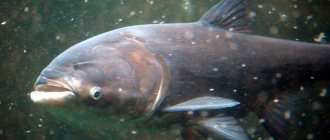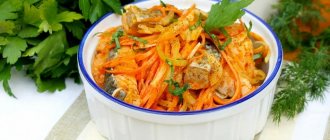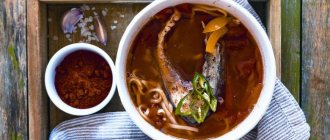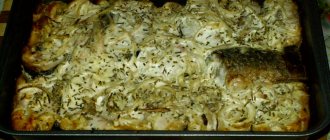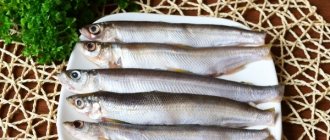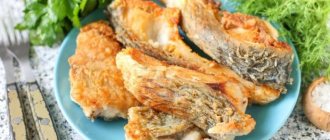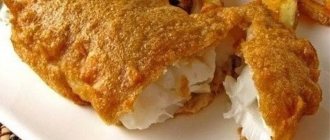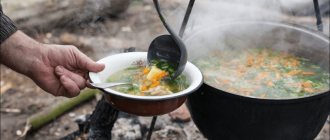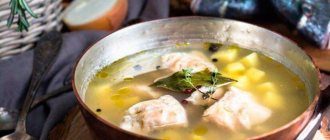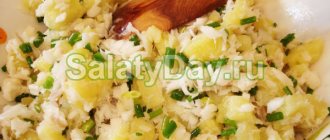Description of carp
Fish from the carp family were first eaten in China in 1000 BC. The name of the fish comes from the Greek word meaning “fruit.” Artificially bred fish began to be called that way because of their fertility: each female can lay more than a million eggs.
Carp is a heat-loving large fish with a large head. Its body is elongated and covered with large scales, the color of which depends on the habitat.
This type of fish spawns when the water temperature rises to 17 degrees Celsius. It feeds at temperatures of 7 degrees and above, and hibernates in winter.
Carp live 50 years. They can weigh up to one kilogram, and at three years of age they are considered sexually mature and capable of reproducing.
Externally, the fish resembles crucian carp, only it has 4 antennae on its lips.
Where are carp found?
This fish lives exclusively in fresh waters of rivers and lakes. In addition, carp are grown in fish hatcheries. This large freshwater fish has an elongated body covered with large grayish scales.
Under natural conditions, carp live on average up to 35 years, but there are long-livers who have celebrated their half-century anniversary.
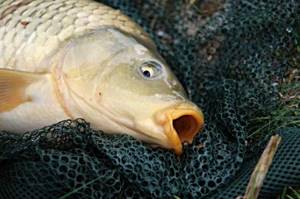
In the wild, an individual can grow up to 90 cm and weigh about 20 kg.

Carp raised in a nursery are more well-fed. Its weight reaches 50 kg, and its height is up to 120 cm. Natural carp has a brighter color and less fat content.
Chemical composition of carp
The beneficial properties of carp lie in its amazing chemical composition. Fish meat contains useful minerals such as:
- potassium;
- sodium;
- molybdenum;
- zinc;
- selenium;
- manganese.
Fish is rich in vitamins. Per 100 grams of product there is the following amount of vitamins:
- riboflavin or B2 – 0.054 mg;
- phyloquinone or K – 0.097 mcg;
- folate or B9 – 9.288 mcg;
- thiamine (B1) – 0.137 mg;
- retinol equivalent (A) – 19.804 mg.
Table
| element name | quantity | daily norm | |
| The nutritional value | |||
| Calorie content | 112 mg | ||
| Squirrels | 16 g | ||
| Carbohydrates | 0 | ||
| Fats | 5.3 g | ||
| Vitamins | |||
| Vitamin B3 | 2.5 mg | 15.059 mg | |
| Vitamin B2 | 0.055 mg | 1.329 mg | |
| Vitamin PP (NE) | 5.5 mg | 15.059 mg | |
| Vitamin B1 | 0.14 mg | 1.159 mg | |
| Vitamin E (TE) | 0.5 mg | 10.882 mg | |
| Vitamin C | 1.5 mg | 69.118 mg | |
| Provitamin A | 0 | 5 mg | |
| Vitamin A (VE) | 0.02 mg | 0.753 mg | |
| Vitamin B5 | 0.2 mg | 3.794 mg | |
| Vitamin B6 | 0.2 mg | 1.512 mg | |
| Vitamin B9 | 9.3 mcg | 285.9 mcg | |
| Vitamin H | 0 | 0.034 mg | |
| Vitamin A | 0.02 mg | 0.753 mg | |
| Vitamin E | 0 | 15 mg | |
| Vitamin B12 | 1.5 mcg | 3 mcg | |
| Vitamin B4 | 65 mg | 500 mg | |
| Vitamin D | 0.025 mg | 0.011 mg | |
| Vitamin K | 0.1 mcg | 85.4 mcg | |
| Macronutrients | |||
| Calcium | 35 mg | 987.5 mg | |
| Magnesium | 25 mg | 276.177 mg | |
| Sodium | 55 mg | 948.824 mg | |
| Potassium | 265 mg | 1807.143 mg | |
| Phosphorus | 210 mg | 852.941 mg | |
| Sulfur | 180 mg | 1000 mg | |
| Silicon | 0 | 30 mg | |
| Microelements | |||
| Iron | 0.8 mg | 13.75 mg | |
| Chlorine | 55 mg | 2300 mg | |
| Copper | 0.13 mg | 0.806 mg | |
| Manganese | 0.15 mg | 2 mg | |
| Fluorine | 0.025 mg | 3 mg | |
| Bor | 0 | 1.4 mg | |
| Aluminum | 0 | 40 mg | |
| Titanium | 0 | 0.85 mg | |
| Strontium | 0 | 1.5 mg | |
| Iodine | 0.05 mg | 0.131 mg | |
| Zinc | 2.08 mg | 9.706 mg | |
| Chromium | 0.055 mg | 0.034 mg | |
| Molybdenum | 4 mcg | 70 mcg | |
| Vanadium | 0 | 0.01 mg | |
| Cobalt | 0.035 mg | 0.1 mg | |
| Nickel | 7 mcg | 100 mcg | |
| Rubidium | 0 | 0.2 mg | |
| Lithium | 0 | 0.2 mg | |
| Selenium | 0.013 mg | 0.04 mg | |
| Tin | 0 | 0.7 mg | |
| Zirconium | 0 | 0.5 mg | |
| Other elements | |||
| Alimentary fiber | 0 | ||
| Organic acids | 0 | ||
| Water | 77.4 g | ||
| Mono- and disaccharides | 0 | ||
| Ash | 1.3 g | ||
| Alcohol | 0 | ||
| Starch | 0 | ||
| Saturated fatty acids | 1.2 g | ||
| Cholesterol | 55 mg | ||
| Unsaturated fatty acids | 0 | ||
This table shows the average norms of elements for an adult.
Nutritional value and calorie content of carp
The benefits and calorie content of carp depend on its processing. When fried or smoked, fish meat will be higher in calories, rich in fat and contain quite a lot of beneficial properties compared to boiled or steamed meat.
How many kilocalories are contained in fish after cooking in one form or another is indicated in the table:
| Type of dish | Kcal in carp meat per 100 g |
| Fried | 197,109 |
| Canned | 141,672 |
| Pickled | 137,586 |
| Baked | 123,908 |
| Raw | 111,704 |
| Stewed | 109,083 |
| Boiled | 101,484 |
Based on the data in the table, we can conclude that this fillet is considered dietary. This is the main benefit. Although fish is easily digestible, it should not be overused. Meat consumed in large quantities can harm the body.
Carp
Carp is a domesticated carp, and its meat is more tender than carp. It was domesticated a long time ago, and that’s why people fell in love with it - because it is not only tasty, but also fertile. Its name is translated from Greek as “fruit”. Carp is a stomachless fish; it takes food without interruption. He is also an omnivore, which makes him fatty and tasty. Its meat is very healthy, because it contains vitamins and all the useful parts of the periodic table.
In the restaurant we use medium-sized carp - two hundred kilos - eight hundred kilos. It’s more convenient to work with them, and most importantly, they taste better. We work with mirror carp - it has a little less bones. The taste of ordinary carp and mirror carp is no different. And one more thing: we don’t take it at all in the summer, when it’s hot. Because carp live mainly in stagnant water - and when its temperature rises strongly, it begins to noticeably smell like mud. The peak season for this fish is from September to the end of the year.
Personally, I really like carp. Every weekend in the fall I buy it, cut it into thick steaks and start frying it. I always fry from the skin, not across it. I blot it with paper napkins - this must be done to remove the mucus - heat a frying pan with a small amount of oil, put in the carp, and the excess fat from under the skin begins to fry. The meat inside may still be half-raw, but the skin must be fried on both sides. Then I remove it onto parchment, lay it with fried onions, sprinkle with homemade sour cream (it doesn’t spread, but lies like caps), put it in the oven, and it simmers quietly: 150–160 degrees, 15–20 minutes. Most tender! I have a Malanka friend - she’s half-Ukrainian, half-Jewish, she says: “Lena, my grandfather was a fisherman, we didn’t live very richly in Kiev and mostly ate his catch, so he taught me for the rest of my life: you can’t eat fish with your teeth, you have to eat it with your lips.” That is, you take a carp, feel the bone with your lips, and then take it out. It's a whole process, a pleasure!
At “Shinka” they also really like carp, we cook a lot of things from it. Another good thing about it is that it goes well with many products. Mushrooms, honey, lemon, vegetables, tomatoes - all this only complements it.
For example, we make stuffed carp - both cold and hot. The hot dish is Berdichev-style carp: the carp is stuffed with its own meat, plus vegetables and spices. We make cutlets, cover them with fish skin and set them to simmer - without water, in the vegetables’ own juice: a large amount of beets, a little less carrots and half of the beets onions. We cover it completely, without leaving any gaps, as people do pilaf, and the steam inside knocks the juice out of the fish and vegetables. There is so much gelatin in the skin of carp that if it is not cooled in time to separate it into portions, then it will all gel. We’ve had this dish before, and will soon return in a slightly different interpretation. And cold stuffed carp is in the form of a sausage, we steam it, and due to the large amount of gelatin it cuts very well. Gastronomically! It is good with various additions - with sour cream and horseradish, and with horseradish and beets, and with pickled vegetables, and with lemon. What, do you already want to eat? Me too, me too.
We also had success with carp stuffed with buckwheat and mushrooms. With honey. You need to take the carp, clean it from the entrails, blot it with paper napkins, grease the inside with honey and lemon and stuff in the prepared buckwheat with onions and mushrooms. Lubricate the top with honey too - and bake in the oven.
Carp baked with homemade sour cream, oyster mushrooms and onions under a cheese crust is also good. But this dish is not for everyone: the carp itself is fatty, but there is sour cream and cheese. But with a crust! This carp is unique: it has no bones at all; my cooks have learned to fillet it well. Do you know how carp bones grow? Some are like this, while others are in the other direction. And when you remove the carcass from the frame, you need to change the direction of the knife at the ridge in the direction of bone growth. This may not be very economical for the home, because in any case you leave some meat on the bones. But you eat carp, which everyone associates with bonyness, and you eat it without bones at all.
Before putting the carp in the oven, I recommend frying it again to render out the fat. Even if you don’t make steaks, but fillets, it should be on the skin. It is necessary to make cuts in the skin so that the fillet retains its shape and does not shrink, roll the skin side in flour and fry on the same side. Turning it over, fry it a little more so that the whites of the meat just set, and that’s it. We remove this semi-finished product - and you can put beets, carrots and onions in layers on top and just bake. You can make an envelope from foil - in its own juice it will be great: we make an envelope, lightly grease it with butter, cut the vegetables into strips, put a pillow of vegetables, put the carp lightly fried or even raw, if you are making a diet version, put it again on top of the vegetables and close the envelope tightly . And into the oven. If it is one piece of fillet, then 7-10 minutes at 180 degrees. If a whole carp - 15-20 minutes at 160 degrees. The larger the fish, the lower the temperature we make - and increase the time so that the heat breaks through.
There are also wonderful carp cutlets - sicheniki. An ancient dish, from time immemorial it was loved in the provinces, especially by those who lived near the water. There are onions, carp meat and mushrooms. We minced the carp meat through a meat grinder, gave us a little bread, fried onion - not very fried, but milky, just stir it a little in a frying pan. Then adjust to taste with salt and coarse ground black pepper, add some water and beat. I recommend diluting minced carp with water, not cream or milk: firstly, we don’t need excess fat, and secondly, they contain a lot of casein - and they dry out the minced meat. To make it juicy and tender, it is better to simply add cold water. Or fine crushed ice, frappe. And add fried mushrooms to the finished minced meat - a good amount: for 800 grams of carp - 200-250 grams of mushrooms. We make it from dry white caps: boil and fry until fragrant. You can, of course, add champignons, but these are sicheniki! Important: mushrooms must be cooled after frying; if you put them hot in raw minced meat, it will sour. Add the mushrooms, mix again, form cutlets and fry them in the usual way in breadcrumbs. They turn out magnificent! They are good with mashed potatoes, baked potatoes, and vegetables. You can also give them a cocktail sauce: for example, horseradish, mayonnaise, cognac. Add a little cognac to the mayonnaise, a little horseradish for flavor, add pepper to taste - and the carp is great with it!
Useful properties of carp
The benefits and harms of carp for the body consist in having both positive and negative properties on health.
Fish contains nutrients and a lot of protein, which is good for children while growing.
Meat is rich in unsaturated Omega-3 fatty acids. They have the following beneficial properties for the body:
- anti-inflammatory;
- prevent cholesterol plaques from depositing in blood vessels, which is why this type of fish is useful for the prevention of atherosclerosis, thrombosis, heart and vascular diseases.
The calcium contained in fish will benefit the human skeletal system. Zinc will improve memory and help you concentrate stronger.
Eating such meat normalizes the functioning of the gastrointestinal tract and nervous system. It will be of particular benefit to diabetics and people with thyroid diseases - thanks to Omega-3 acids.
Carp soup is recommended to be consumed during breastfeeding, pregnancy, and feeding a small child. And well-absorbed calcium will benefit older people by strengthening their skeletal system.
Important! The nutrients in meat strengthen the body's immunity and promote recovery from debilitating diseases.
What are the benefits of carp?
This fish is dietary and, judging by its composition rich in microelements and vitamins, healthy. Eating carp improves the condition of the skin and mucous membranes, and has a beneficial effect on the functioning of the brain and spinal cord.
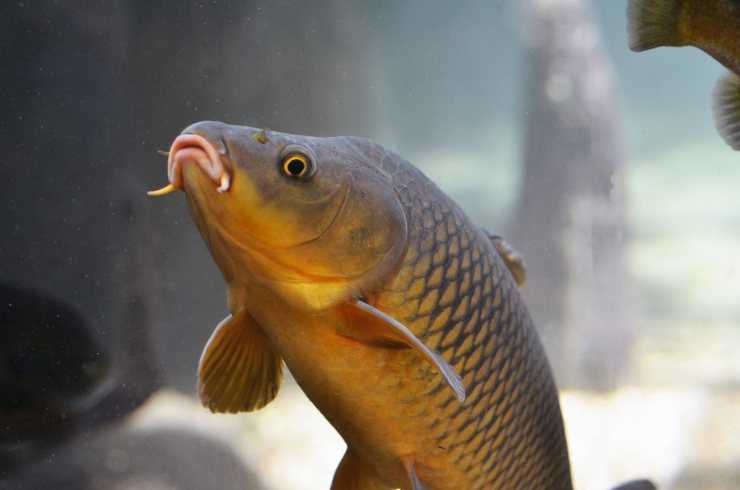
What other benefits are there from eating carp? You can’t list everything - this fish, when consumed regularly, normalizes blood sugar levels - which means it’s perfect for diabetes. Eating it stabilizes the food system.
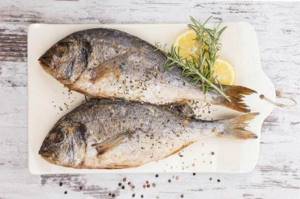
Carp is good for the heart muscle; It is recommended to use it to prevent thyroid diseases and improve metabolism.
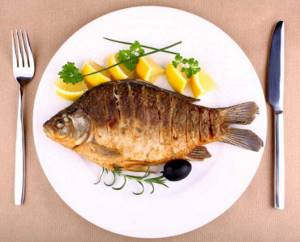
The benefits and harms of carp caviar
Before talking about the beneficial properties of carp caviar, it should be noted that it is often thrown away, considered unsuitable for food, which is completely in vain, since it contains a large amount of lecithin and unsaturated fatty acids.
The calorie content of caviar is 200 kcal per 100 g. In appearance, it is dense, small, and pink in color.
It is completely absorbed by the body without forming waste. The phosphorus, fluorine and calcium contained in it strengthen teeth, bones, improve memory, saturate the body with vitamins, and accelerate the breakdown of fats.
However, such caviar can also be harmful - due to its high cholesterol content: consumed in large quantities, it can cause thrombosis.
Important! Only a moderate amount of caviar can be neutralized by lecithin.
Therefore, if eaten excessively, caviar can become the culprit of excess weight. Therefore, in order to avoid the harm that carp caviar can cause, it is recommended to add it in delicate quantities in daily portions.
How best to prepare it so that this healthy fish has excellent taste is described below.
How to cook delicious carp
The most delicious meat is fried. There is a recipe that, when fried, will not dry out the meat, but will make it crispy and rich. You can buy a carcass everywhere, especially in the fall.
Fried carp
You can best experience the taste of fish if you do not add various additives and spices to it. Ingredients you will need:
- carp – 1 kg;
- pepper - a pinch;
- vegetable oil;
- flour for breading pieces;
- salt;
- lemon.
We recommend reading: Chili peppers: benefits and harms, properties, how to eat them
Preparation steps:
- Rinse the carcass with water and remove scales.
- Gut, wash again from the inside and cut into pieces, first removing the head.
- Place in a plate, sprinkle with salt and black pepper. Sprinkle with lemon juice.
- Let it stand.
- Dust in flour.
- Fry on one side for 5 minutes, on the other for 7 minutes.
Carp baked in the oven
The baked dish has a special taste that is incomparable with other types of cooking. Ingredients you will need:
- carp – 1 kg;
- bell pepper – 0.5 kg;
- eggplants – 0.5 kg;
- carrots – 0.2 kg;
- onion – 0.2 kg;
- garlic – 5 cloves;
- mayonnaise – 3 tbsp. l.;
- lemon, dill, parsley, salt, pepper.
We recommend reading: The benefits and harms of leeks
Preparation steps:
- Wash the fish, remove scales, remove entrails and gills. Leave to dry.
- Mix mayonnaise, pepper and garlic.
- Chop the dill and parsley.
- Salt the meat and brush with the prepared mayonnaise mixture. Place chopped greens inside.
- Cut onions, carrots, eggplants into rings, and peppers into longitudinal pieces.
- Cut the lemon into slices.
- Fry onions, carrots, peppers for 2 minutes.
- Fry the eggplants separately.
- Make cuts on the carp and insert lemon slices.
- Place the cooked vegetables on a baking sheet, and place the fish on top.
- Sprinkle with lemon juice.
- Bake in a preheated oven for 40 minutes at 180°C.
Stuffed carp
Ingredients:
- carp – 2 kg;
- champignons – 0.5 kg;
- onions – 2 pcs.;
- vegetable oil;
- dill, pepper, salt - to taste.
Preparation steps:
- Wash the fish and remove scales.
- Gut and wash the belly.
- Chop the onion and mushrooms.
- Fry the onion and add the champignons.
- Carp and stuff with onions, mushrooms and chopped dill, place on a greased baking sheet.
- Pour vegetable oil on top and bake for 60 minutes at 180°C.
Advice! Carp is served with dry white wine.
We recommend reading: The benefits of white wine and how to make it at home
Stuffed carp
A very tasty and simple dish. We fill the gutted and washed carp carcass with champignons and onions fried in oil (at the end of stewing, the mushrooms and onions need to be salted a little).
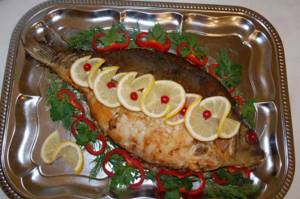
Rub the carp with a mixture of salt and pepper and place in the oven for an hour. Bake the fish at 180°.
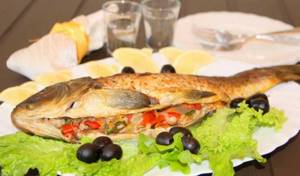
Harm to carp and contraindications
Carp is an omnivorous fish. It lives in muddy water, which may contain substances poisonous to humans, and digs into the mud in search of food. Therefore, harmful substances accumulate in his body along with useful ones.
If the fish was bred in an artificial reservoir, then it may contain residues of antibiotics and artificial bait, which can also cause harm to humans, then the beneficial properties are of little use.
The benefits of carp fish, as well as the harm, depend on the individual characteristics of the person. For some people it can be dangerous simply due to an allergic reaction.
How to choose the right carp
The best way to buy is to catch it from an aquarium right in front of the buyer. If this is not possible at the retail outlet, then you should adhere to the basic rules for choosing fresh fish:
- clean and bright eyes;
- when you press your finger on the carp, the carcass should quickly return to its original shape;
- red gills without mucus;
- Only the scales should be covered with mucus.
Compliance with these simple rules guarantees that the meat will have a full range of beneficial properties and will not cause harm.
